Military Sensors Market Size
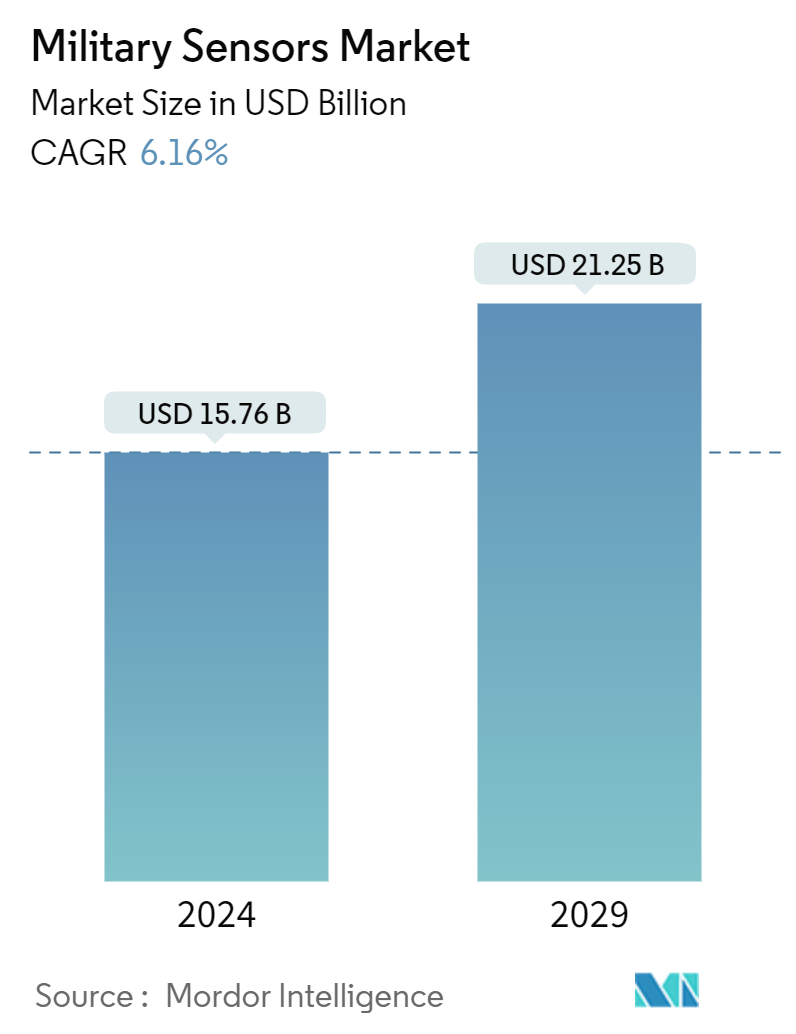
| Study Period | 2019 - 2029 |
| Market Size (2024) | USD 15.76 Billion |
| Market Size (2029) | USD 21.25 Billion |
| CAGR (2024 - 2029) | 6.16 % |
| Fastest Growing Market | Asia Pacific |
| Largest Market | North America |
Major Players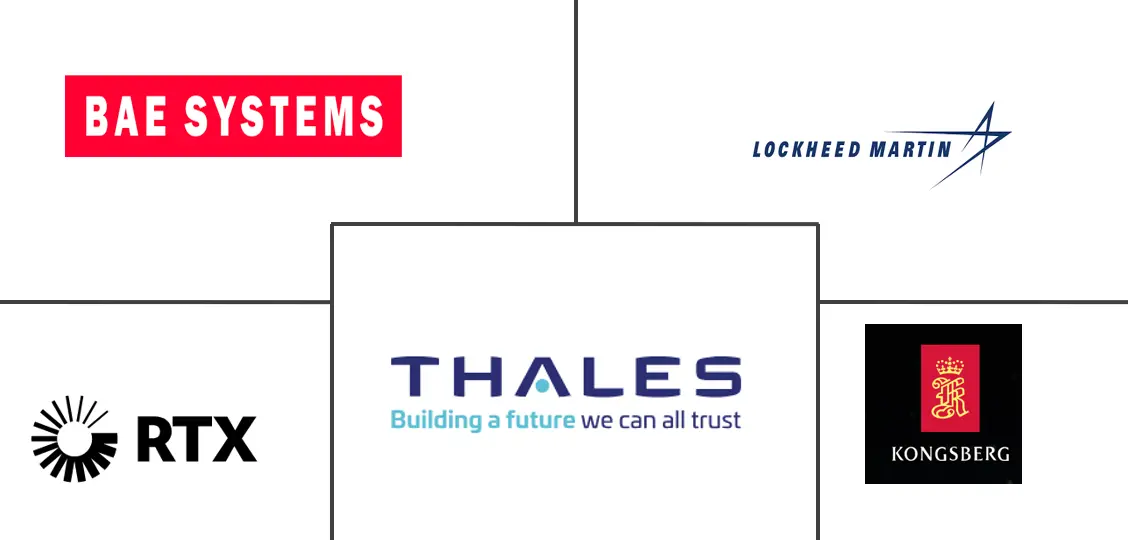
*Disclaimer: Major Players sorted in no particular order |
Need a report that reflects how COVID-19 has impacted this market and its growth?
Military Sensors Market Analysis
The Military Sensors Market size is estimated at USD 15.76 billion in 2024, and is expected to reach USD 21.25 billion by 2029, growing at a CAGR of 6.16% during the forecast period (2024-2029).
The evolution and rapid adoption of microelectromechanical systems (MEMS)-based devices have led to the development of sophisticated micro gyros for navigation and positioning, microbolometers for infrared imaging, and micromirrors for steering laser beams. RF MEMS and nanotechnology could lead to breakthroughs in aerospace and defense applications, such as satellite communications at speeds over 100 GHz and electronically steerable RF phase shifters for true-time delay.
Modern military systems rely heavily on complex software and interconnectivity to perform their missions. Advanced features, such as electronic attacks, sensor fusion, and communications, of cyber-enabled military systems provide a tactical edge to the equipped armed forces against adversary forces or during critical operations in a hostile environment. Factors such as increasing demand for battlespace awareness amongst defense forces, ongoing advancements in MEMS technology, and integration of anti-jamming capabilities with navigation systems will drive the market growth. However, cybersecurity risks, complexity in the designs of military sensors, and lack of accuracy would constrain the market's growth.
Military Sensors Market Trends
Airborne Segment Expected to Register the Highest CAGR During the Forecast Period
Modern military planes are made to do different kinds of missions. An increase in the global aerial fleet has led to a rise in the demand for military sensors in airborne segments. Countries like the US, India, China, Iran, Israel, and Russia, among others, have invested in modernizing and upgrading their existing air fleets. China uses stealth technology in unmanned platforms and is unveiling more UAV variants. Furthermore, rising global expenditure and rising spending on enhancing defense capabilities drive market growth.
Moreover, compared to manned platforms, the cost-effectiveness and ease of operations of unmanned platforms aided the rapid adoption of UAVs in defense applications (for both surveillance and attack operations). Military organizations are also broadly deploying unmanned platforms in conflict regions worldwide. In September 2022, the US Army awarded phase two contracts to defense firms RTX Corporation and L3Harris Technologies, Inc. for developing prototype sensors to support the service’s next-gen airborne intelligence, surveillance, and reconnaissance program dubbed HADES. These factors render a positive outlook for the airborne military sensors segment of the market during the forecast period.
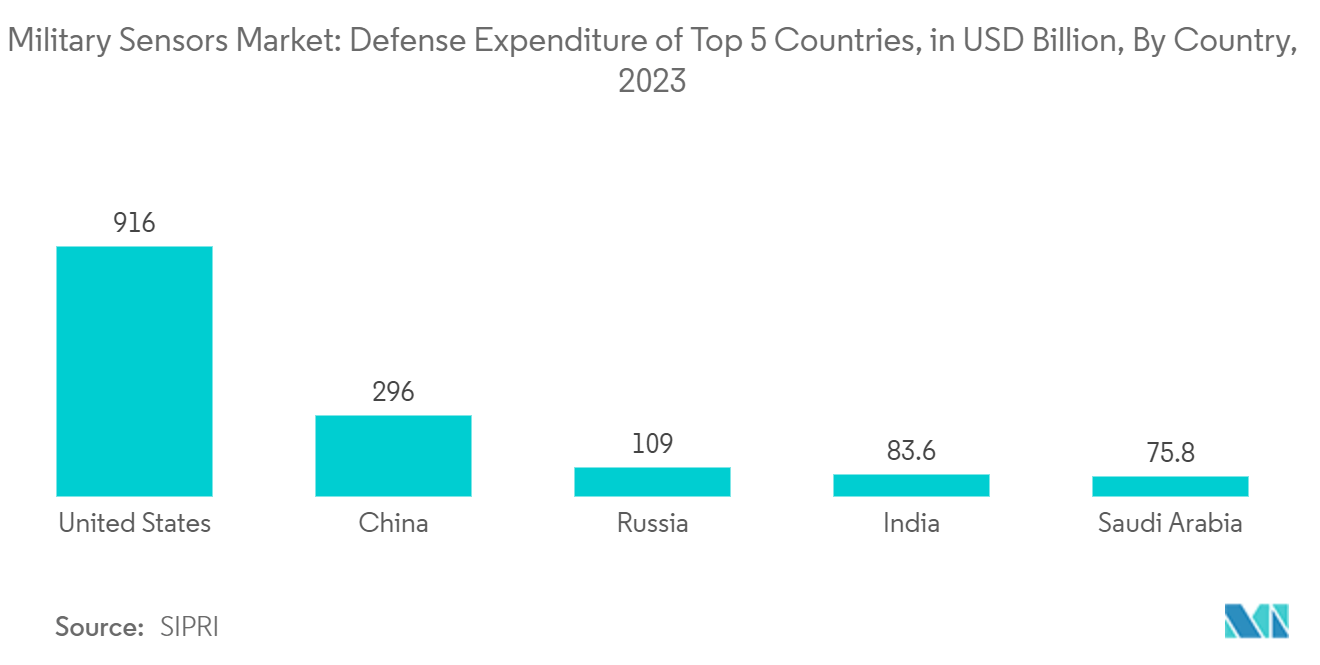
Asia-Pacific is Expected to Generate the Highest Demand During the Forecast Period
The Asia-Pacific region is expected to generate the highest demand for military sensors due to the several ongoing programs fostering the modernization of the regional defense forces during the forecast period. In the Asia-Pacific, several modernization programs are underway to enhance the current capabilities of the commercial and military end-users in the region. For instance, Indonesia’s Defence Ministry sealed a deal with Turkey to acquire 12 cutting-edge drones valued at USD 300 million, marking another step in its ongoing efforts to modernize its aging military equipment.
In terms of operational fleet, the region has the largest fleet of aircraft and rotorcraft, with 14,529 aircraft. Combat aircraft constitute about 4,998, 520 particular purpose aircraft, 46 tankers, 1,008 transport, and 3,079 training and helicopters. The increasing geopolitical tensions between neighboring nations and the rising demand for advanced threat detection systems are expected to aid the market growth in this region.
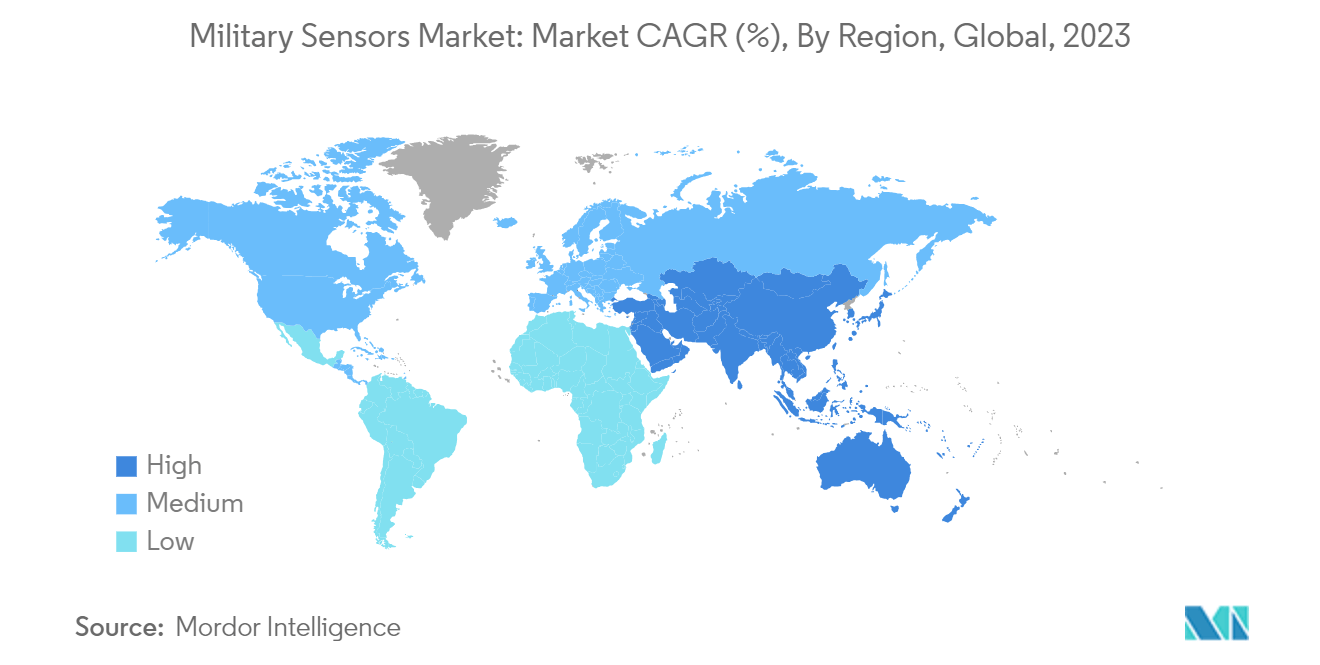
Military Sensors Industry Overview
The military sensors market is semi-consolidated and marked by many prominent players competing for a larger market share. The prominent players in the military sensors market are RTX Corporation, Lockheed Martin Corporation, Kongsberg Gruppen ASA, BAE Systems plc, and THALES.
Vendors are modifying their offerings to enhance current capabilities and introduce revolutionary features to deliver value-added sensor solutions to end users. This helps introduce low-differentiated products at competitive pricing. Furthermore, strategic collaboration between manufacturers is on the rise to develop sophisticated sensors that conform with the design and performance specifications of the end-user defense forces. This is expected to benefit industry stakeholders during the forecast period.
Military Sensors Market Leaders
Lockheed Martin Corporation
RTX Corporation
BAE Systems plc
Kongsberg Gruppen ASA
THALES
*Disclaimer: Major Players sorted in no particular order
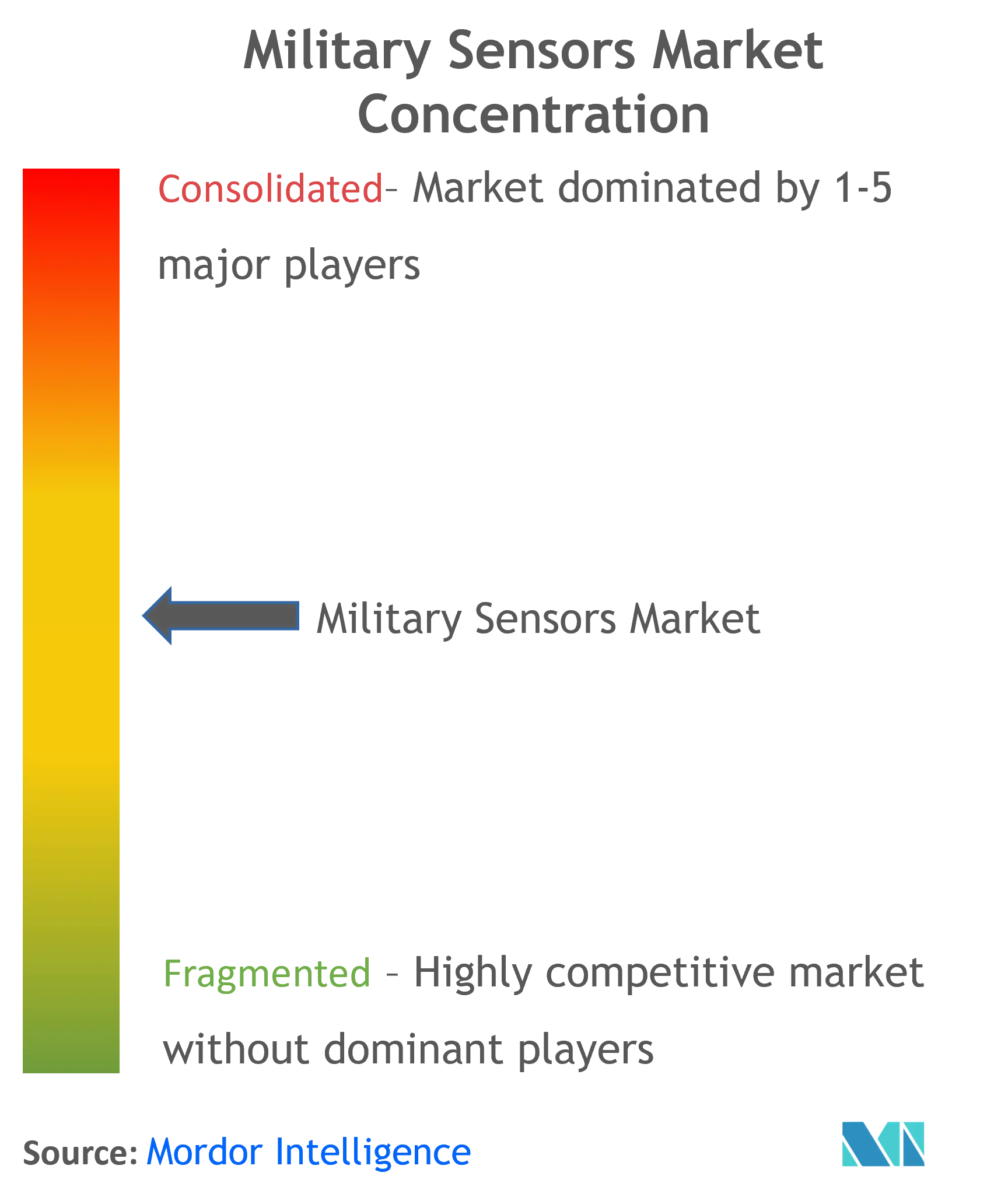
Military Sensors Market News
June 2023: The US Army awarded RTX Corporation a USD 117.5 million contract for low-rate initial production of 3rd Generation Forward Looking Infrared (3GEN FLIR) B-Kit sensors. The advanced targeting sensor systems enhance lethality, survivability, and situational awareness, providing combat overmatch for the Army's ground combat platforms.
December 2022: Leonardo DRS was awarded a USD 39.5 million contract by the US Army to provide advanced infrared sensors for the next-generation sighting systems.
Military Sensors Market Report - Table of Contents
1. INTRODUCTION
1.1 Study Assumptions
1.2 Scope of the Study
2. RESEARCH METHODOLOGY
3. EXECUTIVE SUMMARY
4. MARKET DYNAMICS
4.1 Market Overview
4.2 Market Drivers
4.3 Market Restraints
4.4 Porter's Five Forces Analysis
4.4.1 Bargaining Power of Suppliers
4.4.2 Bargaining Power of Buyers/Consumers
4.4.3 Threat of New Entrants
4.4.4 Threat of Substitute Products
4.4.5 Intensity of Competitive Rivalry
5. MARKET SEGMENTATION
5.1 Application
5.1.1 Intelligence, Surveillance, and Reconnaissance (ISR)
5.1.2 Communication and Navigation
5.1.3 Target Recognition
5.1.4 Electronic Warfare
5.1.5 Command and Control
5.2 Platform
5.2.1 Airborne
5.2.2 Terrestrial
5.2.3 Naval
5.3 Geography
5.3.1 North America
5.3.1.1 United States
5.3.1.2 Canada
5.3.2 Europe
5.3.2.1 United Kingdom
5.3.2.2 France
5.3.2.3 Italy
5.3.2.4 Russia
5.3.2.5 Germany
5.3.2.6 Rest of Europe
5.3.3 Asia-Pacific
5.3.3.1 China
5.3.3.2 Japan
5.3.3.3 India
5.3.3.4 South Korea
5.3.3.5 Rest of Asia-Pacific
5.3.4 Latin America
5.3.4.1 Brazil
5.3.4.2 Mexico
5.3.4.3 Rest of Latin America
5.3.5 Middle East and Africa
5.3.5.1 Saudi Arabia
5.3.5.2 United Arab Emirates
5.3.5.3 South Africa
5.3.5.4 Rest of Middle East and Africa
6. COMPETITIVE LANDSCAPE
6.1 Vendor Market Share
6.2 Company Profiles
6.2.1 Honeywell International Inc.
6.2.2 TE Connectivity Ltd.
6.2.3 RTX Corporation
6.2.4 Lockheed Martin Corporation
6.2.5 THALES
6.2.6 Kongsberg Gruppen ASA
6.2.7 Ultra Electronics Holdings Limited
6.2.8 Aerosonic LLC (Transdigm Group)
6.2.9 General Electric Company
6.2.10 BAE Systems plc
6.2.11 Vectornav Technologies LLC
6.2.12 Viooa Imaging Technology Inc.
6.2.13 Imperx Inc.
7. MARKET OPPORTUNITIES AND FUTURE TRENDS
Military Sensors Industry Segmentation
Several types of sensors are integrated into military systems to enhance their capabilities and ensure that the systems work according to their specifications. The study entails a comprehensive evaluation of the military sensors, including, but not limited to, electro-optical and infrared sensors, seismic sensors, acoustic sensors, magnetic sensors, pressure sensors, temperature sensors, torque sensors, speed sensors, level sensors, flow sensors, force sensors, angle of attack (AoA) sensors, and altimeters.
The military sensors market is segmented by application, platform, and geography. By application, it is divided into Intelligence, Surveillance, and Reconnaissance (ISR), communication and navigation, target recognition, electronic warfare, and command and control. By platform, it is divided into airborne, terrestrial, and naval. The report also covers the market sizes and forecasts for the military sensors market in major countries across different regions. For each segment, the market size is provided in terms of value (USD).
| Application | |
| Intelligence, Surveillance, and Reconnaissance (ISR) | |
| Communication and Navigation | |
| Target Recognition | |
| Electronic Warfare | |
| Command and Control |
| Platform | |
| Airborne | |
| Terrestrial | |
| Naval |
| Geography | ||||||||
| ||||||||
| ||||||||
| ||||||||
| ||||||||
|
Military Sensors Market Research Faqs
How big is the Military Sensors Market?
The Military Sensors Market size is expected to reach USD 15.76 billion in 2024 and grow at a CAGR of 6.16% to reach USD 21.25 billion by 2029.
What is the current Military Sensors Market size?
In 2024, the Military Sensors Market size is expected to reach USD 15.76 billion.
Who are the key players in Military Sensors Market?
Lockheed Martin Corporation, RTX Corporation, BAE Systems plc, Kongsberg Gruppen ASA and THALES are the major companies operating in the Military Sensors Market.
Which is the fastest growing region in Military Sensors Market?
Asia Pacific is estimated to grow at the highest CAGR over the forecast period (2024-2029).
Which region has the biggest share in Military Sensors Market?
In 2024, the North America accounts for the largest market share in Military Sensors Market.
What years does this Military Sensors Market cover, and what was the market size in 2023?
In 2023, the Military Sensors Market size was estimated at USD 14.79 billion. The report covers the Military Sensors Market historical market size for years: 2019, 2020, 2021, 2022 and 2023. The report also forecasts the Military Sensors Market size for years: 2024, 2025, 2026, 2027, 2028 and 2029.
Military Sensors Industry Report
Statistics for the 2024 Military Sensors market share, size and revenue growth rate, created by Mordor Intelligence™ Industry Reports. Military Sensors analysis includes a market forecast outlook to 2029 and historical overview. Get a sample of this industry analysis as a free report PDF download.
